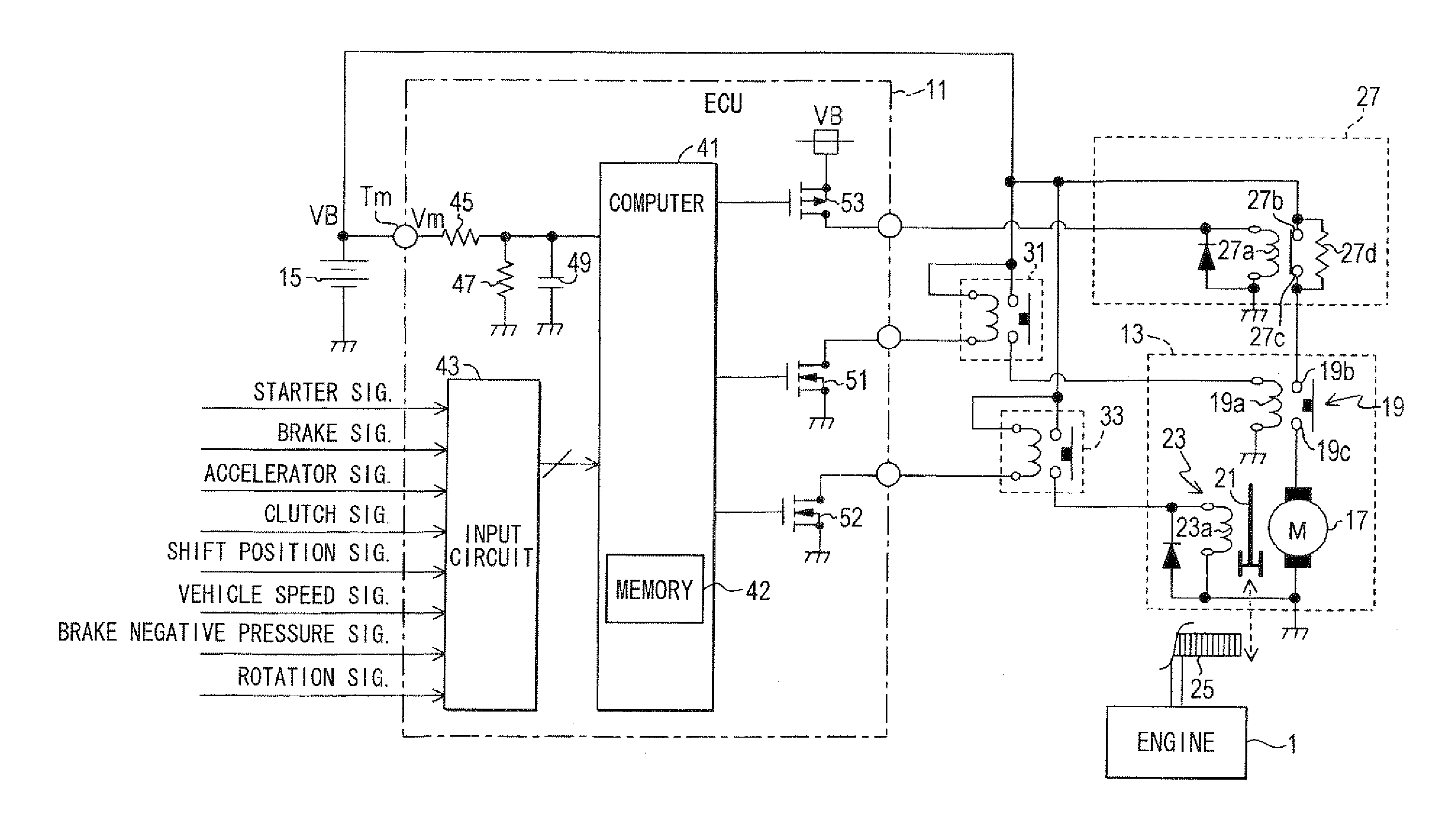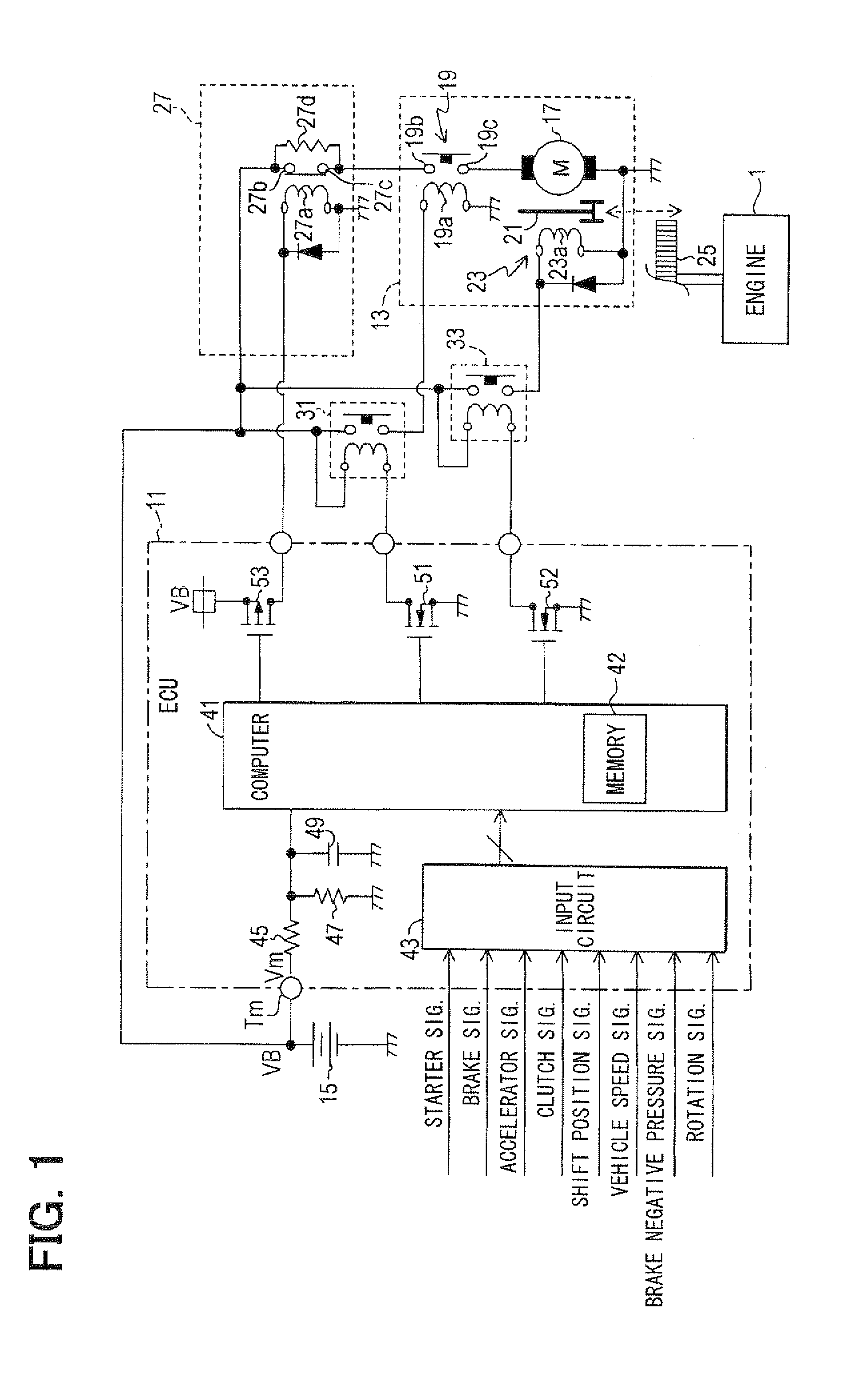Starter controller
a starter and controller technology, applied in the direction of engine starters, machines/engines, instruments, etc., can solve the problems of affecting the operation of the starter motor, the temperature setting of the air-conditioner is anticipated, and the inability to suppress the current in the starter motor, so as to increase the rotation load
- Summary
- Abstract
- Description
- Claims
- Application Information
AI Technical Summary
Benefits of technology
Problems solved by technology
Method used
Image
Examples
first embodiment
[0129]FIG. 1 is a schematic construction diagram showing an ECU 11 according to a first embodiment of the present invention and peripheral devices of the ECU 11. The ECU 11 performs control of a starter 13 for starting an engine 1 of a vehicle (not shown). The ECU 11 also performs idle reduction control for automatically stopping and automatically starting the engine 1. Following explanation will be given on an assumption that a transmission of the vehicle is a manual transmission.
[0130]The ECU 11 receives inputs of a starter signal, which becomes an active level when a vehicle driver performs a starting operation (e.g., manipulation to twist key put in key cylinder to start position or manipulation to push start button), a brake signal from a sensor for detecting whether a brake pedal is stepped on, an accelerator signal from a sensor for detecting whether an accelerator pedal is stepped on, a clutch signal from a sensor for detecting whether a clutch pedal is stepped on, a shift p...
second embodiment
[0224]Next, a second embodiment of the present invention will be explained. As shown in FIG. 11, in the second embodiment, the ICR relay 27 is not provided outside the ECU 11 unlike the first embodiment. Instead, an inrush current suppression circuit 28 that has the same function as the ICR relay 27 is provided inside the ECU 11.
[0225]The inrush current suppression circuit 28 has a transistor group 28a provided in series between the output terminal of the ECU 11 connected to the contact 19b of the electromagnetic switch 19 and the line of the battery voltage VB inside the ECU 11. The inrush current suppression circuit 28 further has a booster circuit 28b for switching on the transistor group 28a and a resistor 28c provided in parallel to the transistor group 28a between the output terminal of the ECU 11 and the line of the battery voltage VB inside the ECU 11.
[0226]The transistor group 28a consists of multiple transistors parallel to each other. In the present embodiment, each trans...
third embodiment
[0231]Next, a third embodiment of the present invention will be described. As shown in FIG. 12, in the third embodiment, a starter 14 is used in place of the starter 13 of the first embodiment. The starter 14 is constructed such that the action for engaging the pinion gear 21 with the ring gear 25 and the energization to the motor 17 are performed in conjunction with each other. That is, the starter 14 cannot operate the pinion gear 21 and the motor 17 independently from each other. The starter 14 is a reinforced starter that has reinforced parts and that has an increased operable time number as compared to a starter mounted on a vehicle that does not perform the idle reduction.
[0232]More specifically, if the coil 23a of the pinion actuation solenoid 23 of the starter 14 is energized, the pinion gear 21 protrudes and engages with the ring gear 25. In addition, due to an electromagnetic force caused by the energization to the coil 23a, the contacts 19b, 19c of the electromagnetic swi...
PUM
 Login to View More
Login to View More Abstract
Description
Claims
Application Information
 Login to View More
Login to View More - R&D
- Intellectual Property
- Life Sciences
- Materials
- Tech Scout
- Unparalleled Data Quality
- Higher Quality Content
- 60% Fewer Hallucinations
Browse by: Latest US Patents, China's latest patents, Technical Efficacy Thesaurus, Application Domain, Technology Topic, Popular Technical Reports.
© 2025 PatSnap. All rights reserved.Legal|Privacy policy|Modern Slavery Act Transparency Statement|Sitemap|About US| Contact US: help@patsnap.com



